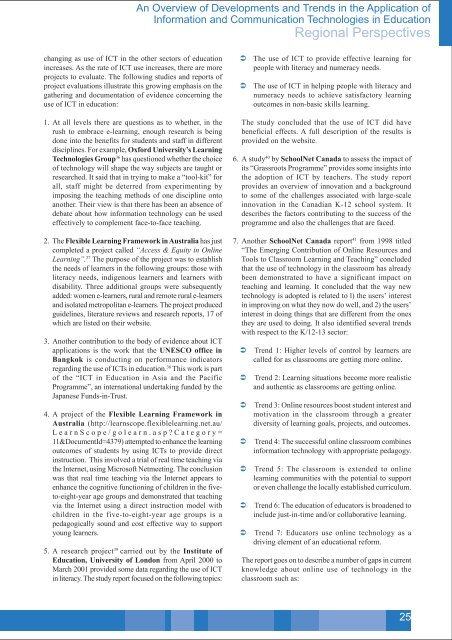Download (PDF, 2.MB) - UNESCO Bangkok
Download (PDF, 2.MB) - UNESCO Bangkok
Download (PDF, 2.MB) - UNESCO Bangkok
- No tags were found...
Create successful ePaper yourself
Turn your PDF publications into a flip-book with our unique Google optimized e-Paper software.
An Overview of Developments and Trends in the Application ofInformation and Communication Technologies in EducationRegional Perspectiveschanging as use of ICT in the other sectors of educationincreases. As the rate of ICT use increases, there are moreprojects to evaluate. The following studies and reports ofproject evaluations illustrate this growing emphasis on thegathering and documentation of evidence concerning theuse of ICT in education:The use of ICT to provide effective learning forpeople with literacy and numeracy needs.The use of ICT in helping people with literacy andnumeracy needs to achieve satisfactory learningoutcomes in non-basic skills learning.1. At all levels there are questions as to whether, in therush to embrace e-learning, enough research is beingdone into the benefits for students and staff in differentdisciplines. For example, Oxford University’s LearningTechnologies Group 36 has questioned whether the choiceof technology will shape the way subjects are taught orresearched. It said that in trying to make a “tool-kit” forall, staff might be deterred from experimenting byimposing the teaching methods of one discipline ontoanother. Their view is that there has been an absence ofdebate about how information technology can be usedeffectively to complement face-to-face teaching.2. The Flexible Learning Framework in Australia has justcompleted a project called “Access & Equity in OnlineLearning”. 37 The purpose of the project was to establishthe needs of learners in the following groups: those withliteracy needs, indigenous learners and learners withdisability. Three additional groups were subsequentlyadded: women e-learners, rural and remote rural e-learnersand isolated metropolitan e-learners. The project producedguidelines, literature reviews and research reports, 17 ofwhich are listed on their website.3. Another contribution to the body of evidence about ICTapplications is the work that the <strong>UNESCO</strong> office in<strong>Bangkok</strong> is conducting on performance indicatorsregarding the use of ICTs in education. 38 This work is partof the “ICT in Education in Asia and the PacificProgramme”, an international undertaking funded by theJapanese Funds-in-Trust.4. A project of the Flexible Learning Framework inAustralia (http://learnscope.flexiblelearning.net.au/LearnScope/golearn.asp?Category=11&DocumentId=4379) attempted to enhance the learningoutcomes of students by using ICTs to provide directinstruction. This involved a trial of real time teaching viathe Internet, using Microsoft Netmeeting. The conclusionwas that real time teaching via the Internet appears toenhance the cognitive functioning of children in the fiveto-eight-yearage groups and demonstrated that teachingvia the Internet using a direct instruction model withchildren in the five-to-eight-year age groups is apedagogically sound and cost effective way to supportyoung learners.5. A research project 39 carried out by the Institute ofEducation, University of London from April 2000 toMarch 2001 provided some data regarding the use of ICTin literacy. The study report focused on the following topics:The study concluded that the use of ICT did havebeneficial effects. A full description of the results isprovided on the website.6. A study 40 by SchoolNet Canada to assess the impact ofits “Grassroots Programme” provides some insights intothe adoption of ICT by teachers. The study reportprovides an overview of innovation and a backgroundto some of the challenges associated with large-scaleinnovation in the Canadian K-12 school system. Itdescribes the factors contributing to the success of theprogramme and also the challenges that are faced.7. Another SchoolNet Canada report 41 from 1998 titled“The Emerging Contribution of Online Resources andTools to Classroom Learning and Teaching” concludedthat the use of technology in the classroom has alreadybeen demonstrated to have a significant impact onteaching and learning. It concluded that the way newtechnology is adopted is related to l) the users’ interestin improving on what they now do well, and 2) the users’interest in doing things that are different from the onesthey are used to doing. It also identified several trendswith respect to the K/12-13 sector:Trend 1: Higher levels of control by learners arecalled for as classrooms are getting more online.Trend 2: Learning situations become more realisticand authentic as classrooms are getting online.Trend 3: Online resources boost student interest andmotivation in the classroom through a greaterdiversity of learning goals, projects, and outcomes.Trend 4: The successful online classroom combinesinformation technology with appropriate pedagogy.Trend 5: The classroom is extended to onlinelearning communities with the potential to supportor even challenge the locally established curriculum.Trend 6: The education of educators is broadened toinclude just-in-time and/or collaborative learning.Trend 7: Educators use online technology as adriving element of an educational reform.The report goes on to describe a number of gaps in currentknowledge about online use of technology in theclassroom such as:25
















